macaca fuscata
Last Saturday, after an epic karaoke session the night before, Richard, Barbie, Jess and I headed out from Tamano to explore the massive island of Shodoshima. Shodoshima has a fairly large population, and is best known for its olive industry, resulting in the predictable omiyage stores of olive chocolate and olive-wearing Kitty-chans.
After much initial confusion, we hopped on a bus towards a beautiful gorge and cable car. We had to change buses along the way, with enough time between buses to squeeze in lunch. Barbie asked the second bus driver about transport from the top of the cable car, and he was kind enough to phone ahead and arrange a taxi to drive us from the cable car to the monkey park, our key destination for the day, and back to the harbour.
After a short, steep bus ride, we arrived at the gorge. The cable car ride to the top was great fun, and the view was spectacular. At the top, we found a dirty concrete cage housing a single macaque. It was one of the saddest things I've ever seen, and if that's not torture, I don't know what is.
We met our taxi and took a scenic drive to the monkey park. The park is home to a massive troop of wild macaques (encouraged to stick around by offerings of food and ample play equipment) and a "monkeys of the world" exhibit. The "monkeys of the world" turned out to be one olive baboon, two ring-tailed lemurs, and two crab-eating macaques, housed in bare, dirty cages, as expected. There were also a couple of caged Japanese macaques (clearly diseased, mentally ill, or something) and a three-legged deer. A pretty sad sight, though it was interesting to see my first olive baboon.
The wild macaques were, for me, a spectacular experience. There were at least two hundred of them, hanging out around a few large, terraced areas with an impressive array of play equipment. It was absolutely wonderful to watch them play and interact, to exchange glances with them (one doesn't stare at a monkey), and to listen to their incessant chatter (I had no idea they had such expressive voices). A rather sad and touching moment happened when a sad, skinny old lady, who had lost most of her hair to (I assume) fleas, scratching and old age, stood up next to Richard and I, looked into my eyes, and extended a hand towards us. Unfortunately we didn't have anything to give her. And yes, I'm still talking about a monkey.
The opportunity to observe a huge community like this was awesome, though the park itself was rather sad and declining. Monkeys really are fascinating, especially macaques and baboons, which are the smartest and most social of all. It's a rather cliched observation to make, but it's a true one: they really are so alike us humans. Everything they do has its reflection in our own behaviour.
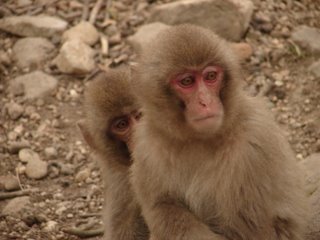
Some of my favourite observations of monkey society (not all shown among Japanese macaques, but if other monkeys do it, why shouldn't they?):
- Monkeys can recognise individual voices. They also know whose infant is whose in their troop. So, if a baby cries, monkeys will look towards its mother to see how she responds, and may alert her if she doesn't notice her baby's cries.
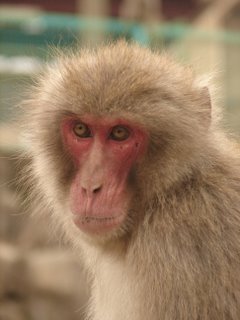 - Low-ranking males sometimes like to babysit, and will even kidnap babies for brief periods. They know that no-one can hit you if you're holding a baby, so babysitting is a way for males to defend themselves from other males. If a babysitting male does cause trouble, however, the higher-ranking males may just wait for him to put the baby down before beating him up. Monkeys take note of everything that happens around them, they remember, and they will wait for the best opportunity to retaliate.
- Low-ranking males sometimes like to babysit, and will even kidnap babies for brief periods. They know that no-one can hit you if you're holding a baby, so babysitting is a way for males to defend themselves from other males. If a babysitting male does cause trouble, however, the higher-ranking males may just wait for him to put the baby down before beating him up. Monkeys take note of everything that happens around them, they remember, and they will wait for the best opportunity to retaliate.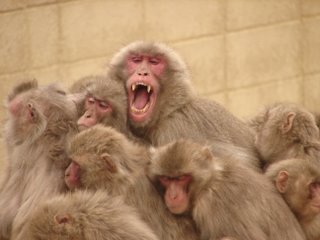 - Don't smile at a monkey. Smiling reveals the teeth, making it an aggressive display: "if you piss me off, I will bite you with these." A few male monkeys with broken or missing teeth have been known to avoid yawning in front of others so as not to show their toothlessness. Some scientists consider this as evidence of self-awareness (because it requires the monkeys to have some understanding of how others see them), a quality once thought to be unique to humans.
- Don't smile at a monkey. Smiling reveals the teeth, making it an aggressive display: "if you piss me off, I will bite you with these." A few male monkeys with broken or missing teeth have been known to avoid yawning in front of others so as not to show their toothlessness. Some scientists consider this as evidence of self-awareness (because it requires the monkeys to have some understanding of how others see them), a quality once thought to be unique to humans.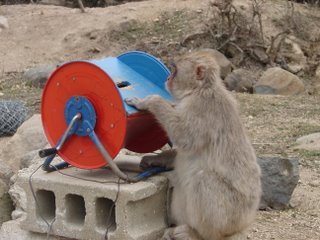 - Monkeys groom each other as a way of social bonding. However, if they can't groom for whatever reason (maybe their hands are busy), they chat instead - just like we do.
- Monkeys groom each other as a way of social bonding. However, if they can't groom for whatever reason (maybe their hands are busy), they chat instead - just like we do.- Lastly, I just noticed that macaques have very pale eyelids. Monkeys do a lot of gesturing with their eyes, so making these signals stand out makes sense.
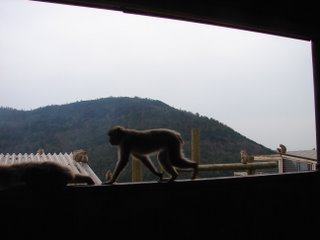

1 Comments:
Thank you so much for the wonderfull pictures and stories. I really enjoyed them all. Keep up the good work
Post a Comment
<< Home